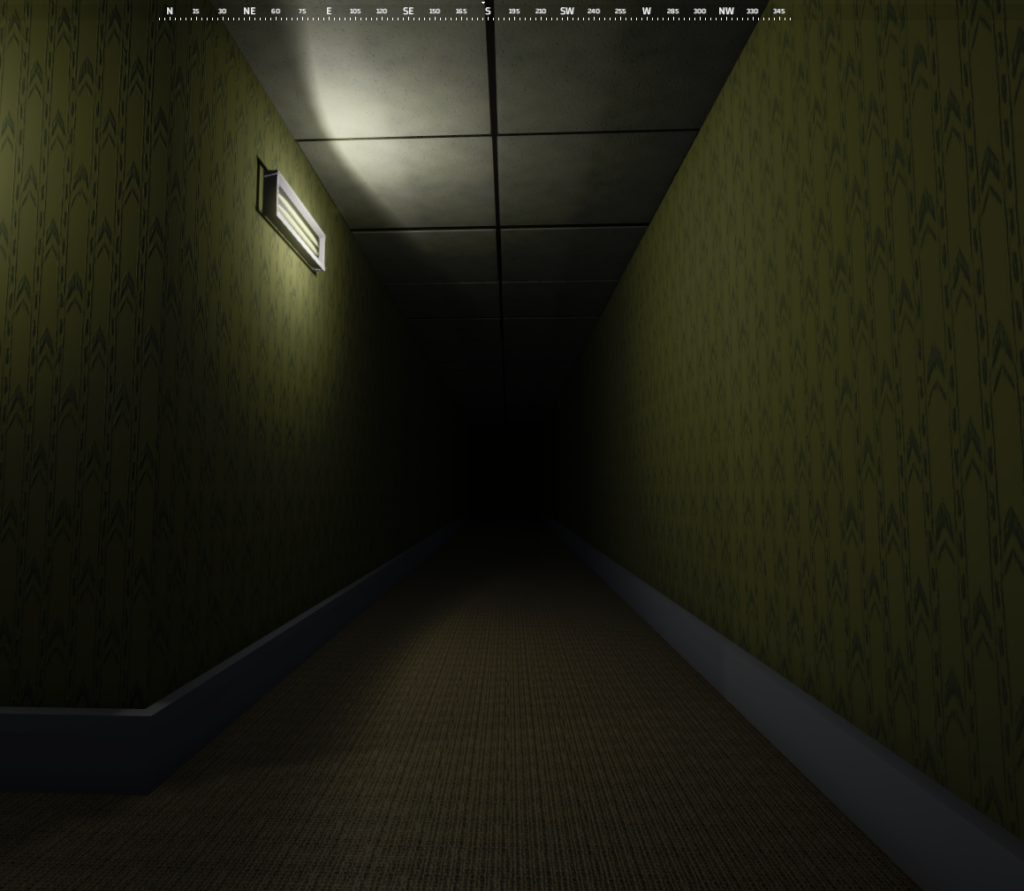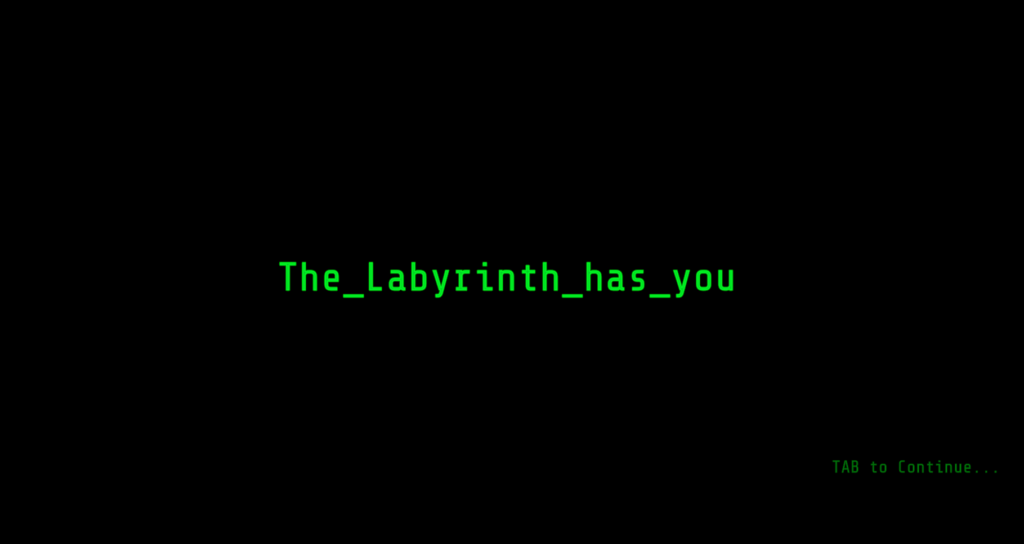Play It Here
A 3D, first-person, story-driven, mind trip through the labyrinth of the human brain.





‘Deceptecho is a mini-production piece created by myself and Tahnee Evans. The goal is to travel through an ever-changing maze, collecting the player characters memories and facing their flaws to get the rogue AI, which has imprisoned you here, to release you.’
Our task was to create a game, from start to finish, which had as much polish we could manage in the time given (3 weeks), whilst following the theme: “Things Are Not What They Seem“.
Immediately what came to mind was the internet folk-horror story going around lately called The Backrooms, which is a beautiful dive into the perception of liminal spaces and minimalist horror.
(Check this out for reference, a great mini series created by youtuber Kane Pixels). We wanted our game to feel a little like The Backrooms.
Our goal when we set out was to create an intriguing setting which had a bit of replay-ability, no difficulty spike (so players of all kinds could play) and to troll our lecturer a little.
For context, he was very fond of trolling us with excessive exposure to the He-man version of 4 Non Blonde’s hit single ‘What’s Up?’ and the Kazoo Kid – Trap Remix, which references can be seen scattered around the game.
Flow
The process of making this game was interesting and quite enjoyable.
Tahnee was able to organise a playtest a week, which gave us constant feedback for us to work with and add content based on how people were playing.
Prototype 1

To create the maze, we used an amazing asset from the unity store called Umbra Maze Magician. This allowed us to get a working level almost immediately.
As for the player character and movement we used a fantastic free player controller by GitHub user Boaheck.
These two assets got us up and running quickly and we had a small prototype for play testers to play.
The original idea was the player would navigate through a small maze, finding different puzzle rooms, until they found an exit. They would then be transported to another, bigger maze. the process would repeat 3 times. each time the player found the next maze, the previous one would regenerate, changing the layout behind them.
The idea was the player doesn’t really know if there is an ending or not. Will they find a way out? Will they not? and keep them engaged with the random things they would find in the maze.
We didn’t have a lot of content yet to show, so we decided to gear the playtest questionnaire towards what players found and would have liked to see within the maze.
Build
- 3 mazes (small, med, large)
- 3 connector rooms (these unique hallways would connect each maze)
- 4 x puzzle rooms
Playtest 1: Results
Results were fairly positive, players enjoyed the maze itself and exploring within it. They requested more rooms and incentive as to why they were in the maze, why did they want to solve it it? other than just for curiosity sake.
We found that not all rooms were experienced by players, also that only 70% of players made it to the last maze, and 16.7% of players were not even aware they could move on to another maze.
From this we gathered that the mazes were too big, players were getting lost and not experiencing the things we wanted them to.
We now had ammo for our next iteration.
Prototype 2

Listening the players, we minimised the first two mazes so people were more likely to find the next one.
We also focussed heavily on incentivising the player to progress. For this we devised a narrative to create meaning for the players.
Check out the design document here.
The TL;DR is that a rogue, partly functioning AI capable of entrapping people in their own minds has trapped you within yours; And it has been programmed with the purpose of fixing your flaws. The player must find and acknowledge flaws in their memories in order to be released.
The memories in which players find display bodies of text regarding common human flaws, followed by an line of ‘acceptance’.
I tried to make them broad enough that people could relate, but also specific enough so they wouldn’t read like horoscopes.
Once players had found all memories, a new door at the beginning of the maze would unlock, leading them to a small narrative conclusion and an escape from the maze.

For design we lent heavily into The Matrix’s style of presenting technology by use of the green font and 1’s and 0’s.
We also added 3 more rooms with memories for the players to encounter; a room full of ducks quacking, a library for players to climb around and a room which forces players to crouch through and find the exit.



Build
- 3 x mazes
- 3 x connector rooms
- 7 x memory rooms
- a narrative
Playtest 2: Results
The added narrative was a massive hit with our play-testers. As most were expecting maybe an entity to be added to chase them, or some kind of timer mechanic to gamify the experience a bit more, the narrative touching on some common faults of our own caught people off-guard (which was reported as a good thing! phew).
Good news aside, some players were still not finding the exit. And time for us was running short.
It was time to think about scope.
Prototype 3


We decided to axe the extra mazes and have the larger size. This way, the interesting points were condensed into a smaller area, allowing for players to find each memory and the exit to regenerate the maze and hopefully find a new memory upon re-entering the maze.
We kept the connector rooms, but now they teleported the player at their end to the required destination.
I also wanted to further utilise the maze generator plugin, its such a cool plugin that I wanted the players to see that too. I worked it into a memory room where players can generate their own mini mazes and see how the maze they’re in is being made!


Build
- 1 small maze
- 3 x connector rooms
- 8 x memory rooms
- a narrative
Playtest 3: Results
Success! 100% of play testers were able to complete it. and the condensing of the maze and memory rooms into a smaller area seemed to satisfy both kind of gamers we had playtesting. Fast players who were there for the goals were able to zip around the maze, find the exit and progress quickly; whereas slower players who would walk and get into the atmosphere would not be penalised with boredom as they would always stumble upon a memory room after a few long hallways.
The only feedback we got from this play test was that it was a bit repetitive at this point, and I could see their fatigued with it.
The maze needed to change more, and be interesting each time a player plays the game
Prototype 4 (final version)
To combat the playtest fatigue. I decided to have the maze degrade and devolve as the player collected memories, to keep the game visually interesting whilst giving visual cues for progression. This also tied in nicely with the idea of the AI itself not being fully functional.
The program you are in is falling apart as you progress.
The maze now had 3 stages; Healthy, Sick & Decrepit.
These states changed the atmosphere of the maze heavily. We made variations of all the rooms and focussed on creating different connector rooms attached to each state so players wouldn’t always be running through the same areas.



So now, depending on how many memories the player had collected, they would be presented with different variations of rooms and heavily differing connector rooms. As sometimes lots of memory rooms appeared quickly, and other times rooms would be slow to appear. This created a feeling of the environment evolving differently with each play through, as sometimes you would miss a connector room or memory room variation.
The idea of the “Health” of the maze was to reflect the condition of the deteriorating AI program falling apart as the player is successfully overcoming their “flaws”.
As the player accepts their flaws and/or overcomes them, there is less reason for the AI to function, as it is fulfilling its purpose! So it degrades as it shuts off less vital systems.
Build
- 1 small maze
- 3 x connector rooms (x3 for each state)
- 8 x memory rooms (x3 for each state)
- a narrative
- changing state of maze based on progression
Playtest 4: Results
At this stage play-testers were pretty happy with the state of the game, and some said if they were handed the game now, they would view it as a finished product.
This was enough for us as time was almost up!
We threw in a few more atmosphere building details, such as random dialogue pop ups from the AI whilst exploring the maze, particle effects & soundscapes to keep it strange and interesting.
Once added everything we could, we polished what could in the time left and submitted the project just in time!
Gameplay Demo
Retrospective
In hindsight, there is not much ‘gamification’ to our game, as we chose to focus on the story-telling element more than anything. And there were plenty of opportunities to create more gameplay moments within each room, such as mini games or other puzzles. This ultimately had us lose marks on our ‘game’. But I’m still proud of what we made in 3 weeks for a team of 2!
My biggest take away from the experience would be how helpful and important playtesting is! like wow!
From the first play test we were able to set a creative direction and really hone in on what people enjoyed. It helped us weed out our bad ideas thrown around in meetings and not waste any time working on things we hoped people would enjoy. We held seniority in absolute design decisions and did not take every suggestion on board, but having more minds in the fray for a varied opinion absolutely helped us to define our vision.
Thanks for your time!
I hope this write-up was a bit insightful in to the way I work and you found it enjoyable. I’d love it if you wanted to play the game yourself, because you can;
https://university-assignments.itch.io/deceptecho
Try it out if you like, let me know your thoughts, and have a nice day 🙂 be kind to yourself.

